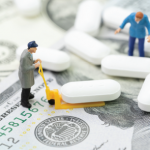In American healthcare, a drug’s efficacy does not always determine its cost. Drug charges in the U.S. are generally the highest in the world, and this is not by accident. First, we are the only country that allows drug companies to set their own prices. To market a drug in the U.S., a manufacturer must gain approval from the Food and Drug Administration (FDA), whose task is to determine the safety and efficacy of a product without consideration of its cost. Period. That is the law. In Europe and Canada, regulatory agencies maintain oversight of pricing and have declined access for some pricey products whose efficacy has been questioned.
This asymmetry in the pricing leads to another cost conundrum, one that creates pressure for firms to squeeze even more profit from their sales in the less regulated American market to offset the lower profit margins earned elsewhere.2
But wait, there’s more. High drug costs are inevitable, thanks to a byzantine and highly opaque network of drug procurement involving many participants with conflicting objectives. Because insurance coverage is provided by myriad employers, government agencies and private insurers, there are countless drug formularies to contend with, each equipped with its own set of rules. Wouldn’t costs decrease if all these payers were brought together into a single or a handful of systems? Possibly, but this concept has not been well received in our country where the American psyche has traditionally favored the rights and autonomy of the individual over the collective needs of the group. Further, the unavoidable drug rationing that can ensue in systems that limit costs is viewed with great suspicion in the land where the words of the Revolutionary patriot Patrick Henry, “Give me liberty, or give me death,” still resonate.2
This cost conundrum extends far beyond the realm of sophisticated biologic drugs and nowadays includes many simple to produce generic drugs. The price of some old generic products has soared, because certain manufacturers have concluded that they are mispriced. Readers may recall the fiasco following the startling rise in the cost of pyrimethamine, a drug first released in 1955 that is used to treat protozoal infections.3 Literally overnight, the cost per pill zoomed from $13.50 to $750.
Rheumatologists may recall a drug we often relied upon when injectable gold failed our rheumatoid arthritis patients: d-penicillamine. Although this drug fell by the wayside decades ago, it is still useful as a copper chelating drug in those rare patients with Wilson’s disease, but with the jaw dropping charge of $27,000 for 100 capsules.4 There is deflazocort, a corticosteroid drug that barely gained traction in our specialty when it was released decades ago, but recently won approval in the U.S. to treat Duchenne muscular dystrophy at an annual cost ranging from $54,000 to $89,000.5,6 Another steroid that has been marketed to rheumatologists, adrenocorticotropic hormone gel (ACTH), carries a similar price tag.7 We have witnessed the astronomical rise in the price of colchicine and other longstanding favorites, such as hydroxychloroquine and methotrexate, that have been “repriced” to enhance their profitability.
The Pharmacy of Smoke & Mirrors
Over the past decade a new and powerful player has emerged that has created even more cost confusion: the pharmacy benefit managers (PBMs). What began as a sleepy industry that managed drug formularies and provided their customers with an accounting of their benefits has evolved into a commanding force in healthcare. Today, more than 80% of the population purchase their drugs through a PBM and just three of them control 75% of the market, with a combined operating profit of $10.1 billion last year, an increase of 30% in a mere three years.8



